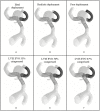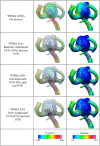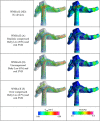Virtual Flow-T Stenting for Two Patient-Specific Bifurcation Aneurysms
- PMID: 34803876
- PMCID: PMC8595090
- DOI: 10.3389/fneur.2021.726980
Virtual Flow-T Stenting for Two Patient-Specific Bifurcation Aneurysms
Abstract
The effective treatment of wide necked cerebral aneurysms located at vessel bifurcations (WNBAs) remains a significant challenge. Such aneurysm geometries have typically been approached with Y or T stenting configurations of stents and/or flow diverters, often with the addition of endovascular coils. In this study, two WNBAs were virtually treated by a novel T-stenting technique (Flow-T) with a number of braided stents and flow-diverter devices. Multiple possible device deployment configurations with varying device compression levels were tested, using fast-deployment algorithms, before a steady state computational hemodynamic simulation was conducted to examine the efficacy and performance of each scenario. The virtual fast deployment algorithm based on a linear and torsional spring analogy is used to accurately deploy nine stents in two WNBAs geometries. The devices expand from the distal to proximal side of the devices with respect to aneurysm sac. In the WNBAs modelled, all configurations of Flow-T device placement were shown to reduce factors linked with increased aneurysm rupture risk including aneurysm inflow jets and high aneurysm velocity, along with areas of flow impingement and elevated wall shear stress (WSS). The relative position of the flow-diverting device in the secondary daughter vessel in the Flow-T approach was found to have a negligible effect on overall effectiveness of the procedure in the two geometries considered. The level of interventionalist-applied compression in the braised stent that forms the other arm of the Flow-T approach was shown to impact the aneurysm inflow reduction and aneurysm flow pattern more substantially. In the Flow-T approach the relative position of the secondary daughter vessel flow-diverter device (the SVB) was found to have a negligible effect on inflow reduction, aneurysm flow pattern, or WSS distribution in both aneurysm geometries. This suggests that the device placement in this vessel may be of secondary importance. By contrast, substantially more variation in inflow reduction and aneurysm flow pattern was seen due to variations in braided stent (LVIS EVO or Baby Leo) compression at the aneurysm neck. As such we conclude that the success of a Flow-T procedure is primarily dictated by the level of compression that the interventionalist applies to the braided stent. Similar computationally predicted outcomes for both aneurysm geometries studied suggest that adjunct coiling approach taken in the clinical intervention of the second geometry may have been unnecessary for successful aneurysm isolation. Finally, the computational modelling framework proposed offers an effective planning platform for complex endovascular techniques, such as Flow-T, where the scope of device choice and combination is large and selecting the best strategy and device combination from several candidates is vital.
Keywords: T-stenting technique (Flow-T); hemodynamic simulation; inflow reduction; virtual fast deployment algorithm; wide necked cerebral aneurysms.
Copyright © 2021 Lyu, Ventikos, Peach, Makalanda and Bhogal.
Conflict of interest statement
The authors declare that the research was conducted in the absence of any commercial or financial relationships that could be construed as a potential conflict of interest.
Figures







Similar articles
-
Virtual flow-diverter treatment planning: The effect of device placement on bifurcation aneurysm haemodynamics.Proc Inst Mech Eng H. 2017 May;231(5):432-443. doi: 10.1177/0954411916673674. Epub 2016 Oct 25. Proc Inst Mech Eng H. 2017. PMID: 27780870
-
High-fidelity virtual stenting: modeling of flow diverter deployment for hemodynamic characterization of complex intracranial aneurysms.J Neurosurg. 2015 Oct;123(4):832-40. doi: 10.3171/2014.11.JNS14497. Epub 2015 Jun 19. J Neurosurg. 2015. PMID: 26090829 Free PMC article.
-
A Virtual Comparison of the eCLIPs Device and Conventional Flow-Diverters as Treatment for Cerebral Bifurcation Aneurysms.Cardiovasc Eng Technol. 2019 Sep;10(3):508-519. doi: 10.1007/s13239-019-00424-3. Epub 2019 Jul 8. Cardiovasc Eng Technol. 2019. PMID: 31286438 Free PMC article.
-
Hemodynamic impact of cerebral aneurysm endovascular treatment devices: coils and flow diverters.Expert Rev Med Devices. 2014 Jul;11(4):361-73. doi: 10.1586/17434440.2014.925395. Expert Rev Med Devices. 2014. PMID: 24918904 Review.
-
Endovascular Treatment of Wide-Neck Bifurcation Aneurysm: Recent Trends in Coil Embolization with Adjunctive Technique.J Neuroendovasc Ther. 2024;18(3):75-83. doi: 10.5797/jnet.ra.2023-0072. Epub 2024 Jan 13. J Neuroendovasc Ther. 2024. PMID: 38559450 Free PMC article. Review.
Cited by
-
Fusiform versus Saccular Intracranial Aneurysms-Hemodynamic Evaluation of the Pre-Aneurysmal, Pathological, and Post-Interventional State.J Clin Med. 2024 Jan 18;13(2):0. doi: 10.3390/jcm13020551. J Clin Med. 2024. PMID: 38256685 Free PMC article.
-
Predictive computational framework to provide a digital twin for personalized cardiovascular medicine.Commun Med (Lond). 2025 Aug 25;5(1):370. doi: 10.1038/s43856-025-01055-7. Commun Med (Lond). 2025. PMID: 40855240 Free PMC article.
-
Treatment for middle cerebral artery bifurcation aneurysms: in silico comparison of the novel Contour device and conventional flow-diverters.Biomech Model Mechanobiol. 2024 Aug;23(4):1149-1160. doi: 10.1007/s10237-024-01829-3. Epub 2024 Apr 8. Biomech Model Mechanobiol. 2024. PMID: 38587717 Free PMC article.
References
LinkOut - more resources
Full Text Sources
Research Materials

